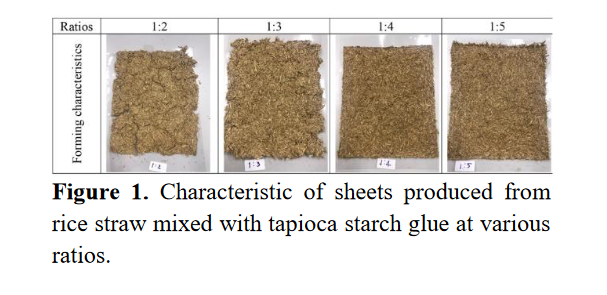Assessment of Fermented Rice Straw as Nutritive Substances for Bio-based Plant Pot
DOI:
https://doi.org/10.53848/ssstj.v10i2.547Keywords:
Plant pot, Rice straw, Fermentation, Soil nourishment, EnzymeAbstract
This research aims to develop bio- based nurseries or plant pots that contain soil nourishment from agricultural waste, namely rice straw. Tapioca starch glue as a binder was mixed with rice straw and then pressed by a hydraulic compression machine to form the sheet. To promote soil nourishment, the straw was fermented. The fermentations with and without enzyme assistance were compared as well as the fermentation time. The tensile strength of the specimens was assessed through a tensile test, revealing a surprising increase in strength with fermentation. The key distinction between the specimens with and without enzyme assistance was the time it took to reach the maximum value. Without the presence of enzyme, the specimens reached a maximum tensile strength of 0. 67 MPa after 7 days of fermentation. For fermentation with enzyme assistance, this value increased to 0. 81 MPa but required 14 days of fermentation to reach its maximum point. Not only the fermentation duration but also the inclusion of enzymes showed a slightly impact on water absorption and water swelling. Spectrophotometry was employed to analyze the value of phosphorus ( P) and potassium ( K) , while the amount of nitrogen ( N) was determined by the Kjeldahl method. As expected, soil nourishment can be promoted by fermentation and boosted by enzymes. The sheet from straw fermented with the enzyme at 21 days gives the
highest soil nourishment, i.e., 17.90%w/w for total K2O, 0.40%w/w for total P2O5, and 1.89%w/w for total N.
References
Conneway, R., Verlinden, S., Koeser, A. K., Evans,M., Schnelle, R., Anderson, V., & Stewart, J.R. (2015). Use of alternative containers for long- and short-term greenhouse crop production. HortTechnology, 25(1), 26-34.doi:10.21273/horttech.25.1.26
Department of Agriculture. (2016). Method validation on analysis of water soluble potassium in chemical fertilizers follow the notification of Ministry of Agriculture and Cooperatives Re: Prescribing the method of analysis of chemical fertilizers, B.E. 2559, method 1.12.01 for accreditation to ISO/IEC17025: 2005. Retrieved from https://www.doa.go.th/oard8/wp-content/uploads/2019/08/v6102.pdf
Evans, M. R., Taylor, M., & Kuehny, J. (2010).Physical properties of biocontainers for greenhouse crops production. HortTechnology, 20(3), 549-555.doi:10.21273/horttech.20.3.549
Glissmann, K., & Conrad, R. (2000). Fermentation pattern of methanogenic degradation of rice straw in anoxic paddy soil. FEMS Microbiology Ecology, 31(2), 117-126.doi:10.1111/j.1574-6941.2000.tb00677.x
Jusoh, M. L., Manaf, L. A., & Latiff, P. A. (2013).Composting of rice straw with effective microorganisms (EM) and its influence on compost quality. Iranian Journal of Environmental Health Science and Engineering, 10(1), 17. doi:10.1186/1735-2746-10-17
Kathong, S. , & Ruangviriyachai, C. ( 2014) .Determination of nitrogen, phosphorus and potassium in liquid organic fertilizer. KKU Research Journal ( Graduate Studies) , 14( 4) ,57-68.
Kumari, D., & Singh, R. (2020). Ultrasonic assisted petha waste water pretreatment for rice straw for optimum production of methane and ethanol using mixed microbial culture.Renewable Energy, 145, 682-690.doi:10.1016/j.renene.2019.06.082
Kumari, D., & Singh, R. (2022). Rice straw structure changes following green pretreatment with petha wastewater for economically viable bioethanol production. Scientific Reports, 12,10443. doi:10.1038/s41598-022-14627-7
Liang, Y. S., Yuan, X. Z., Zeng, G. M., Hu, C. L.,Zhong, H., Huang, D. L., … Zhao, J. J. (2010).Biodelignification of rice straw by Phanerochaete chrysosporium in the presence of dirhamnolipid. Biodegradation, 21(4), 615-624. doi:10.1007/s10532-010-9329-0
Nambuthiri, S., Fulcher, A., Koeser, A. K., Geneve,R., & Niu, G. (2015). Moving toward sustainability with alternative containers for greenhouse and nursery crop production: A review and research update. HortTechnology, 25(1), 8-16. doi:10.21273/horttech.25.1.8
Office of Agricultural Economics. (2022).Retrieved from http://www.oae.go.th/assets/portals/1/fileups/prcaidata/files/percent%20rice%20production%2064.pdf
Piyang, T., Chaichan, W., & Sagulsawasdipan, K.(2018). Environment-friendly plant pot production from palm oil sludge and mushroom cultured waste. RMUTSV Research Journal, 10(3), 497-511.
Schettini, E., Santagata, G., Malinconico, M.,Immirzi, B., Mugnozza, G. S., & Vox, G.(2013). Recycled wastes of tomato and hemp fibres for biodegradable pots: Physico-chemical characterization and field performance. Resources, Conservation and Recycling, 70, 9-19.doi:10.1016/j.resconrec.2012.11.002
Sopunna, K., Pasom, W., Woradong, K., & Chaiwangrach, A. (2015). Fabrication and properties of biological plant pots. SNRU Journal of Science and Technology, 7(2), 1-7.
Sun, Y., Niu, G., Koeser, A. K., Bi, G., Anderson,V., Jacobsen, K., … Lovell, S. T. (2015).Impact of biocontainers on plant performance and container decomposition in the landscape.HortTechnology, 25(1), 63-70.doi:10.21273/horttech.25.1.63
Tiquia, S. M., & Tam, N. F. Y. (2002).Characterization and composting of poultry litter in forced-aeration piles. Process Biochemistry, 37(8), 869-880.doi:10.1016/S0032-9592(01)00274-6
Van de Wetering, J., & Athalage, S. (2010).Biodegradable planters (U.S. Patent No.7681359B2). U.S. Patent and Trademark Office.
Xia, T., Sun, E., Tang, W., Huang, H., Wu, G., & Jin, X. (2018). Structural and thermal stability changes of rice straw fibers during anaerobic digestion. BioResources, 13(2), 3447-3461. doi:10.15376/biores.13.2.3447-3461

Downloads
Published
How to Cite
Issue
Section
License
Copyright (c) 2023 Suan Sunandha Rajabhat University

This work is licensed under a Creative Commons Attribution 4.0 International License.











